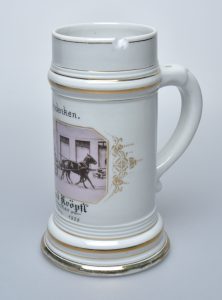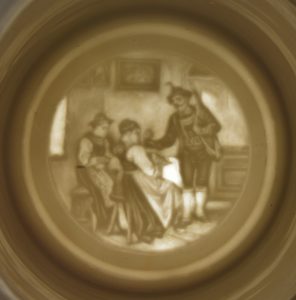
Lithophane from Germany, Thuringia, Plaue porcelain manufactory, model number PPM 293, c. 1850-1880, image known as “The Grandfather” after a painting by Friedrich Eduard Meyerheim (1808-1876).
Andreas Heege, 2019
Lithophanes (loosely translated as “luminous stones”, and also known as “transparencies” at the time) were independently developed in Berlin on 1827 and in Montreuil-sous-Bois near Paris in 1828, and were later produced in numerous other places including Meissen (Steckelings 1994; Steckelings 2009; Steckelings 2013). Lithophane plaques were created by casting liquid porcelain paste into a plaster of Paris mould into which an image had been carved. Some plaques bear faint linear traces on the reverse side from the removal of excess paste (e.g. RMC XI.361a). The fronts show the cast relief. Due to the variation in depth of the relief and the fact that porcelain is translucent, a detailed image formed when the piece was illuminated from behind, for instance as part of a lampshade or fitted in a frame and hung in a window. The thicker and denser the paste the deeper the shade; the thinner the paste, the more transparent and translucent the plaque. If illuminated by a candle, the flickering flame made the image appear more “animated”.


The same technique could also be used on the base of a porcelain tankard, so that the drinker would be surprised by the appearance of a picture when held up against the light (e.g. RMC H2015.21).
Lithophanes had their heyday between c. 1855 and 1870. The motifs were usually inspired by paintings or engravings by well-known contemporary artists and included religious and mythological themes, portraits of famous people, genre, landscape and architectural scenes as well as erotic depictions. They usually reflected the Biedermeier and historicism zeitgeist. More than 2,000 motifs are known today.
Homepage with numerous lithophanes
Translation Sandy Haemmerle
References:
Steckelings 1994
Karl-Heinz W. Steckelings, Leuchtender Stein. Über den Werdegang der Lithophanie, in: Photo-Antiquaria 21, 1994, 39-48.
Steckelings 2009
Karl-Heinz W. Steckelings, Leuchtender Stein. Ein Beitrag zur Geschichte des Lichtschirms, der Porzellan-, Papier- und Glas-Lithophanie unter Berücksichtigung verwandter lithophaner Objekte und der Lithophanie, eingeordnet in die historische Entwicklung der jeweiligen Manufakturen, in: Photo-Antiquaria 36, 2009, 4-13.
Steckelings 2013
Karl-Heinz W. Steckelings, Leuchtender Stein – Die Geschichte der Lithophanie vom 18. bis ins 20. Jahrhundert, Dresden 2013.

